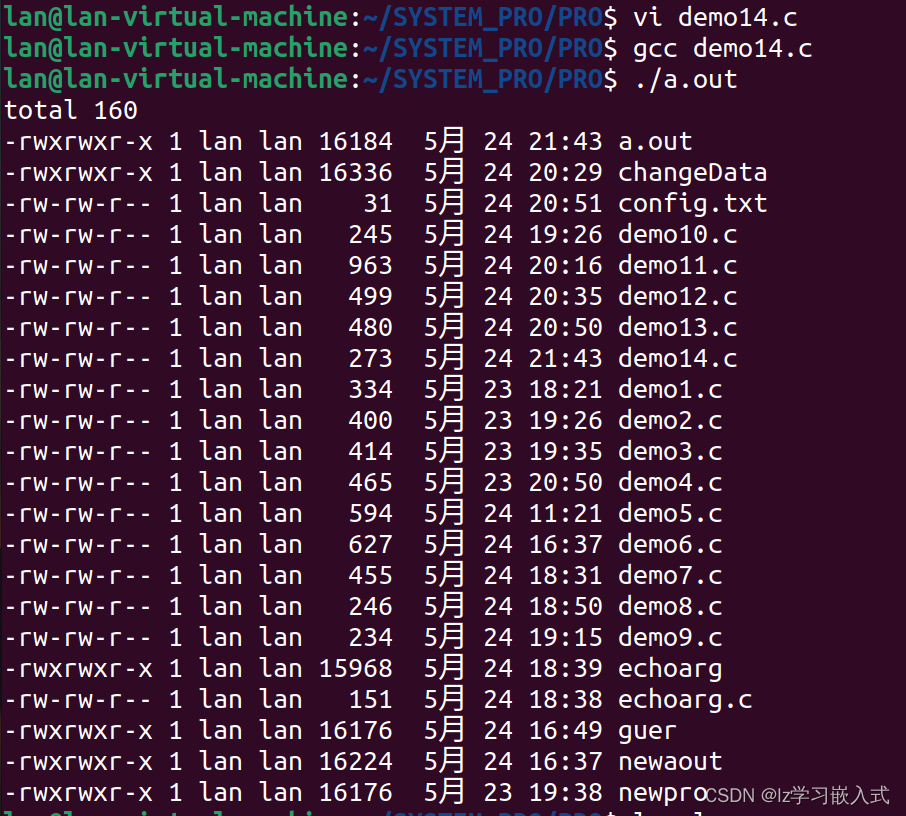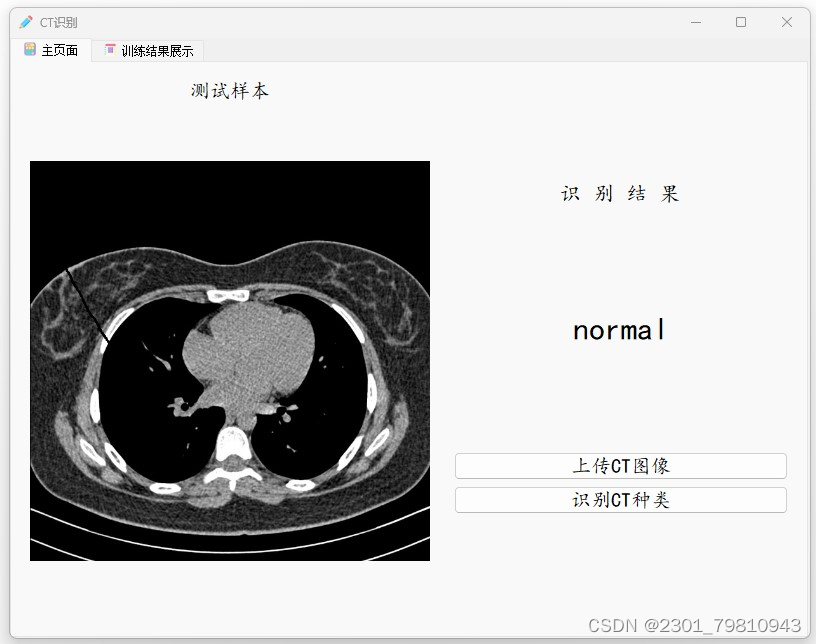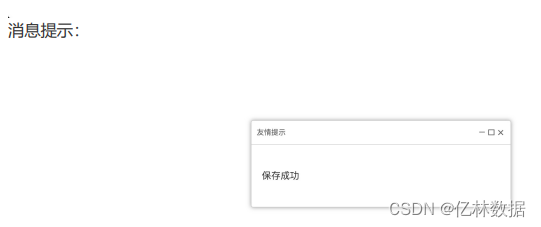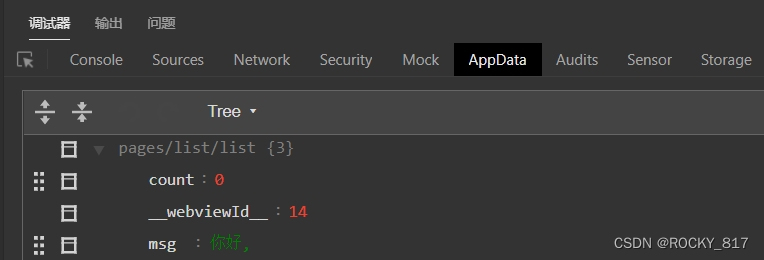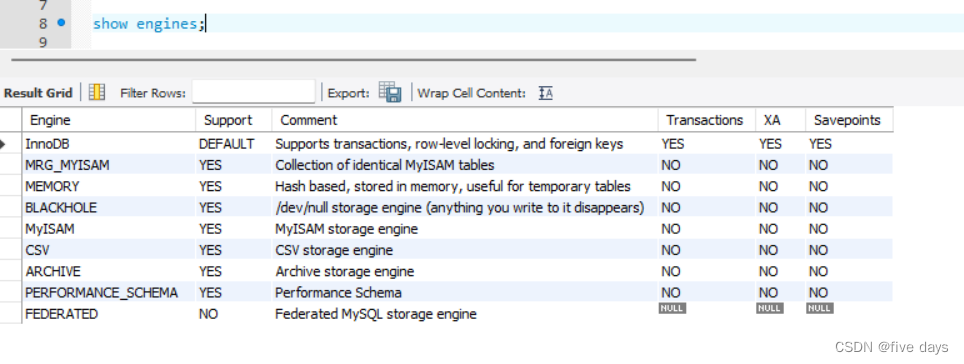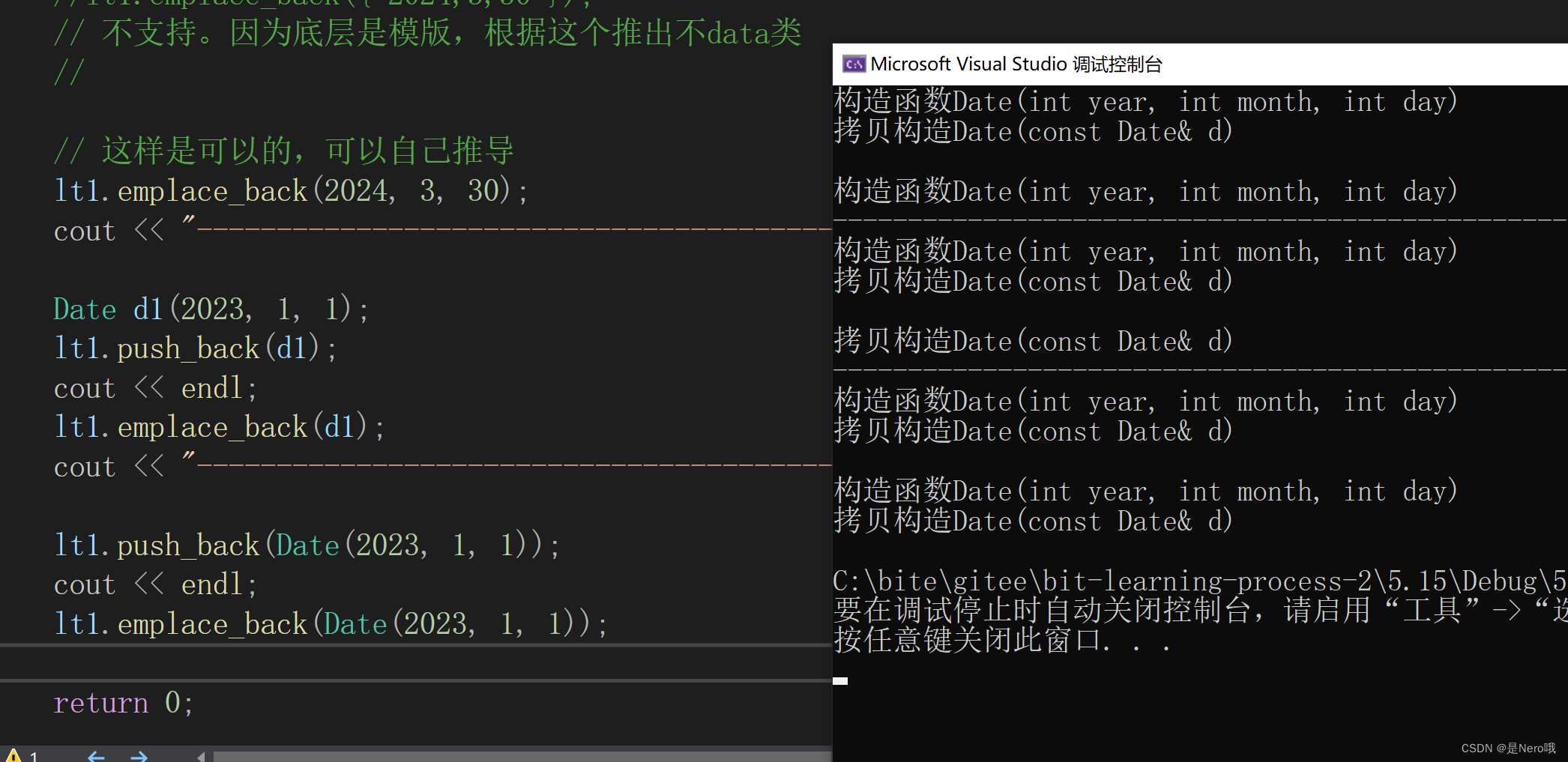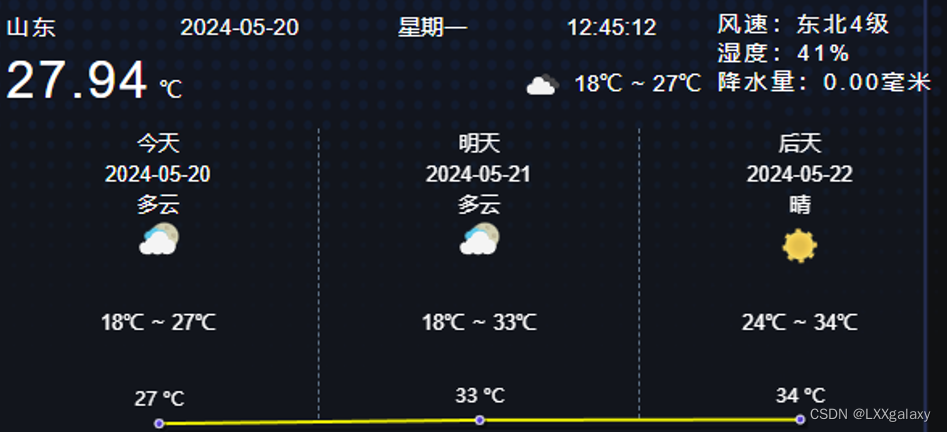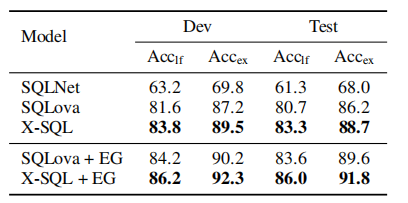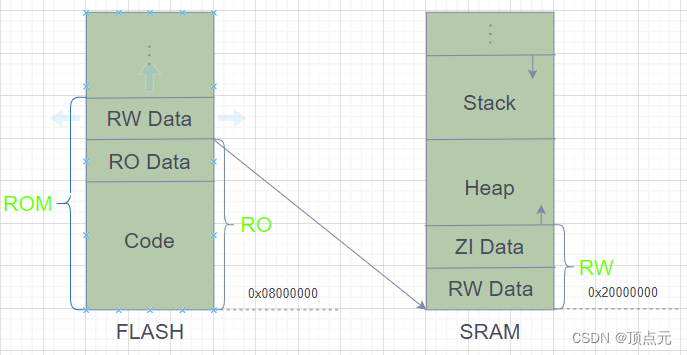文章目录
- 前言
- 目标
- 环境背景
- U-Boot如何自动调起菜单
- U-Boot添加自定义命令
- 实践
前言
在某个厂家的开发板中,在进入它的U-Boot后,会自动弹出一个菜单页面,输入对应的选项就会执行对应的功能。如SD卡镜像更新、显示设置等:
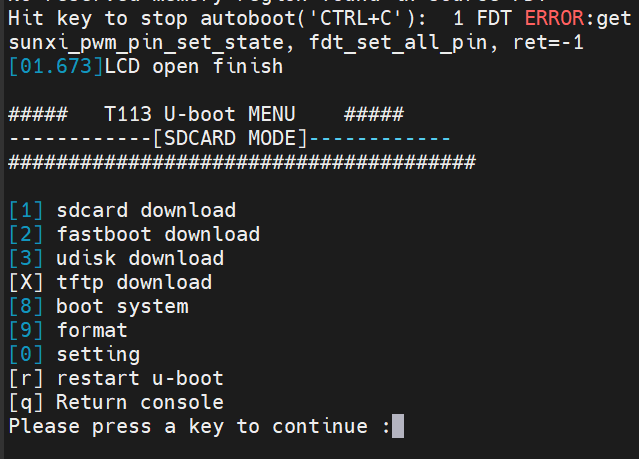
目标
本文主要分析U-Boot在程序中的执行顺序,又如何在U-Boot阶段调起菜单?相信大家都试过,在U-Boot倒数结束前按任意按键后,会进入U-Boot命令行模式。
这里先留一个问题:如何做到按键按下后,调启的是自己的U-Boot菜单,而不再是进入冷冰冰的命令行模式?
环境背景
本文介绍所用的U-Boot版本:2018
U-Boot如何自动调起菜单
U-Boot的入口程序文件是<u-boot>/common/main.c,入口函数main_loop():
/* We come here after U-Boot is initialised and ready to process commands */
/* 在U-Boot初始化并准备好处理命令之后,我们来到这里。 */
void main_loop(void)
{
const char *s;
bootstage_mark_name(BOOTSTAGE_ID_MAIN_LOOP, "main_loop");
#ifdef CONFIG_VERSION_VARIABLE
env_set("ver", version_string); /* set version variable */
#endif /* CONFIG_VERSION_VARIABLE */
cli_init(); //命令初始化有关,初始化 hush shell 相关的变量
run_preboot_environment_command(); //获取环境变量 perboot 的内容
#if defined(CONFIG_UPDATE_TFTP)
update_tftp(0UL, NULL, NULL);
#endif /* CONFIG_UPDATE_TFTP */
s = bootdelay_process(); //此函数会读取环境变量 bootdelay 和 bootcmd 的内容
if (cli_process_fdt(&s))
cli_secure_boot_cmd(s);
autoboot_command(s); //开启倒计时,并在倒计时结束前检测是否有按键按下
cli_loop(); //命令行处理函数(即进入U-Boot命令行)
panic("No CLI available");
}
关键函数是autoboot_command(),该函数的实现在<u-boot>/common/autoboot.c:
void autoboot_command(const char *s)
{
debug("### main_loop: bootcmd=\"%s\"\n", s ? s : "<UNDEFINED>");
if (stored_bootdelay != -1 && s && !abortboot(stored_bootdelay)) { // 倒计时过程中,没有按键按下
#if defined(CONFIG_AUTOBOOT_KEYED) && !defined(CONFIG_AUTOBOOT_KEYED_CTRLC)
int prev = disable_ctrlc(1); /* disable Control C checking */
#endif
run_command_list(s, -1, 0); // 倒计时结束后,启动内核
#if defined(CONFIG_AUTOBOOT_KEYED) && !defined(CONFIG_AUTOBOOT_KEYED_CTRLC)
disable_ctrlc(prev); /* restore Control C checking */
#endif
}
#ifdef CONFIG_MENUKEY
if (menukey == CONFIG_MENUKEY) {
s = env_get("menucmd");
if (s)
run_command_list(s, -1, 0);
}
#endif /* CONFIG_MENUKEY */
}
进入autoboot_command()后,先看第一个if:
void autoboot_command(const char *s)
{
...
if (stored_bootdelay != -1 && s && !abortboot(stored_bootdelay))
...
}
这里有三个条件:
stored_bootdelay != -1:stored_bootdelay是倒数的总时间,就是常见的3秒、5秒不等;s:传进来的参数s不能为空;!abortboot(stored_bootdelay):该函数会从stored_bootdelay开始倒计时,期间判断是否有按键按下。函数实现如下,倒计时过程中若检测到按键按下,则令abort=1。无按键按下,则abort=0。最后返回abort。
static int __abortboot(int bootdelay)
{
int abort = 0;
unsigned long ts;
#ifdef CONFIG_MENUPROMPT
printf(CONFIG_MENUPROMPT);
#else
printf("Hit any key to stop autoboot: %2d ", bootdelay);
#endif
/*
* Check if key already pressed
*/
if (tstc()) { /* we got a key press */
(void) getc(); /* consume input */
puts("\b\b\b 0");
abort = 1; /* don't auto boot */
}
while ((bootdelay > 0) && (!abort)) {
--bootdelay;
/* delay 1000 ms */
ts = get_timer(0);
do {
if (tstc()) { /* we got a key press */
abort = 1; /* don't auto boot */
bootdelay = 0; /* no more delay */
# ifdef CONFIG_MENUKEY
menukey = getc();
# else
(void) getc(); /* consume input */
# endif
break;
}
udelay(10000);
} while (!abort && get_timer(ts) < 1000);
printf("\b\b\b%2d ", bootdelay);
}
putc('\n');
return abort;
}
刚刚说了,abortboot()函数执行期间有按键按下的话,abortboot()会返回1,那就不会进入第一个if,程序会接着往下运行直至该函数运行结束。autoboot_command()结束后继续返回到main_loop(),随后立刻执行cli_loop(),进入我们所熟悉的U-Boot命令行模式。
void main_loop(void)
{
...
autoboot_command(s); //检查倒计时是否结束
cli_loop(); //命令行处理函数
}
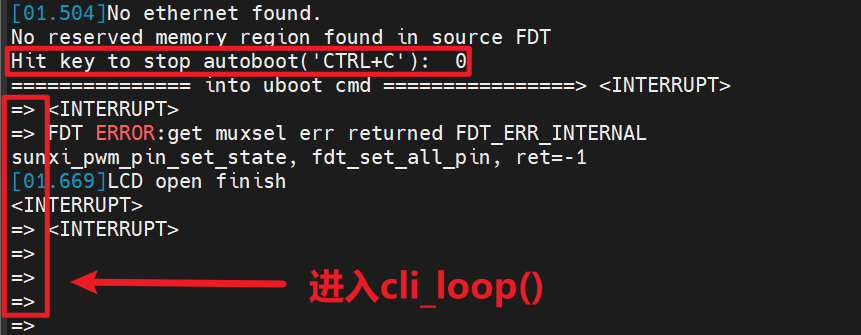
至此,就实现了U-Boot倒数期间,有按键按下,则进入U-Boot的命令行模式。
现在继续回到第一个if:
void autoboot_command(const char *s)
{
...
if (stored_bootdelay != -1 && s && !abortboot(stored_bootdelay)) { // 倒计时过程中,没有按键按下
#if defined(CONFIG_AUTOBOOT_KEYED) && !defined(CONFIG_AUTOBOOT_KEYED_CTRLC)
int prev = disable_ctrlc(1); /* disable Control C checking */
#endif
run_command_list(s, -1, 0); // 倒计时结束后,启动内核
#if defined(CONFIG_AUTOBOOT_KEYED) && !defined(CONFIG_AUTOBOOT_KEYED_CTRLC)
disable_ctrlc(prev); /* restore Control C checking */
#endif
}
...
}
如果在autoboot倒计时结束前,一直没有按键按下呢?那abortboot()最后会返回0,第一个if的三个条件全部满足。进入if,run_command_list()执行一系列命令后,启动内核。注意,这里的现象是直接启动内核,run_command_list()后的程序不再执行。
解析到这里,我们得出一个结论:在autoboot倒计时中,如果有按键按下的话,会进入U-Boot的命令行模式。无按键按下则在倒计时结束后直接启动内核。
那现在可以回答第一个问题,如何做到按下按键后,是自启动U-Boot菜单,而不是进入U-Boot命令行呢?答案是在执行cli_loop()之前,我们可以在autoboot检测到按键按下后,调用run_command()函数执行menu命令,从而调起菜单。
void autoboot_command(const char *s)
{
debug("### main_loop: bootcmd=\"%s\"\n", s ? s : "<UNDEFINED>");
if (stored_bootdelay != -1 && s && !abortboot(stored_bootdelay)) {
#if defined(CONFIG_AUTOBOOT_KEYED) && !defined(CONFIG_AUTOBOOT_KEYED_CTRLC)
int prev = disable_ctrlc(1); /* disable Control C checking */
#endif
run_command_list(s, -1, 0);
#if defined(CONFIG_AUTOBOOT_KEYED) && !defined(CONFIG_AUTOBOOT_KEYED_CTRLC)
disable_ctrlc(prev); /* restore Control C checking */
#endif
}
//启动菜单
run_command("menu", 0);
#ifdef CONFIG_MENUKEY
if (menukey == CONFIG_MENUKEY) {
s = env_get("menucmd");
if (s)
run_command_list(s, -1, 0);
}
#endif /* CONFIG_MENUKEY */
}
U-Boot添加自定义命令
难道通过run_command()执行menu命令后,菜单就自己出来了?这是一个理所当然的猜想。实际上U-Boot根本不认识menu命令:
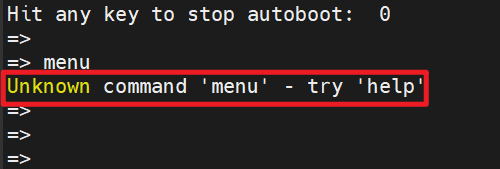
接下来看看如何添加U-Boot命令,参考一下别人的代码:
int do_brightness(cmd_tbl_t *cmdtp, int flag, int argc, char * const argv[])
{
int rcode = 0;
ulong side;
ulong bright;
switch (argc) {
case 3:
side = simple_strtoul(argv[1], NULL, 10);
bright = simple_strtoul(argv[2], NULL, 10);
if ((side >= 0) && (side <= 3) &&
(bright >= 0) && (bright <= 1000)) {
vcxk_setbrightness(side, bright);
rcode = 0;
} else {
printf("parameters out of range\n");
printf("Usage:\n%s\n", cmdtp->usage);
rcode = 1;
}
break;
default:
printf("Usage:\n%s\n", cmdtp->usage);
rcode = 1;
break;
}
return rcode;
}
U_BOOT_CMD(
bright, 3, 0, do_brightness,
"sets the display brightness\n",
" <side> <0..1000>\n side: 0/3=both; 1=first; 2=second\n"
);
先看最底下的U_BOOT_CMD,这是一个宏,用来添加U-Boot命令:
#define U_BOOT_CMD(_name, _maxargs, _rep, _cmd, _usage, _help) \
U_BOOT_CMD_COMPLETE(_name, _maxargs, _rep, _cmd, _usage, _help, NULL)
- _name:命令的名字
- _maxargs:添加的命令最多有几个参数
- _rep:是否重复(1重复,0不重复),指在U-Boot命令行按下Enter键的时候,重复执行上次的命令
- _cmd:执行函数(即执行该命令后,运行哪个函数)
- _usage:短帮助信息
- _help:长帮助信息
再来看看执行函数do_brightness的声名:
int (*cmd)(struct cmd_tbl_s *cmdtp, int flag, int argc, char *const argv[]);
- cmdtp:Table entry describing the command (see above).
- flag:A bitmap which may contain the following bit
- CMD_FLAG_REPEAT - The last command is repeated.
- CMD_FLAG_BOOTD - The command is called by the bootd command.
- CMD_FLAG_ENV - The command is called by the run command.
- argc:执行命令时,传入的参数数量
- argv:传入的参数
实践
下面,添加一个U-Boot菜单,不过只作打印,没有实际功能。
在<u-boot>/drivers下创建一个名为mymenu的文件夹:

在mymenu文件夹下创建mymenu.c,内容如下:
#include <common.h>
#include <command.h>
#include <linux/ctype.h>
#include <cli.h>
#include <fs.h>
static int do_mymenu(struct cmd_tbl_s *cmdtp, int flag, int argc, char *const argv[])
{
if(argc != 2)
return 0;
if(!strcmp(argv[1], "pageone"))
printf("\n======== pageone ========\n");
else if(!strcmp(argv[1], "pagetwo"))
printf("\n======== pagetwo ========\n");
else
printf("\n======== pageone ========\n");
printf("== [1] xxxxxx\n");
printf("== [2] xxxxxx\n");
printf("== [3] xxxxxx\n");
printf("== [4] xxxxxx\n");
printf("=========================\n\n");
return 0;
}
U_BOOT_CMD(
mymenu, 2, 1, do_mymenu,
"here is uboot mymenu\n",
"here is uboot mymenu, make in 2024-05-15\n"
);
还需在mymenu文件夹下创建一个Makefile文件,内容如下:
obj-y += mymenu.o
最后修改<u-boot>/drivers/下的Makefile,在结尾加上如下内容,表示要编译mymenu路径下的文件:

编译U-Boot,更新U-Boot,重启单板,在U-Boot倒计时结束前,按任意按键进入U-Boot命令行,输入mymenu后,可以看到命令被正确识别,对应的函数也执行成功:
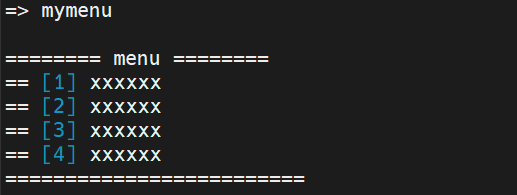
那如何做到按任意按键后直接调起菜单呢?上面有说过,可以在autoboot检测到按键按下后,调用run_command()函数执行mymenu命令,从而调起菜单。
void autoboot_command(const char *s)
{
debug("### main_loop: bootcmd=\"%s\"\n", s ? s : "<UNDEFINED>");
if (stored_bootdelay != -1 && s && !abortboot(stored_bootdelay)) {
#if defined(CONFIG_AUTOBOOT_KEYED) && !defined(CONFIG_AUTOBOOT_KEYED_CTRLC)
int prev = disable_ctrlc(1); /* disable Control C checking */
#endif
run_command_list(s, -1, 0);
#if defined(CONFIG_AUTOBOOT_KEYED) && !defined(CONFIG_AUTOBOOT_KEYED_CTRLC)
disable_ctrlc(prev); /* restore Control C checking */
#endif
}
//启动菜单
run_command("mymenu", 0);
#ifdef CONFIG_MENUKEY
if (menukey == CONFIG_MENUKEY) {
s = env_get("menucmd");
if (s)
run_command_list(s, -1, 0);
}
#endif /* CONFIG_MENUKEY */
}
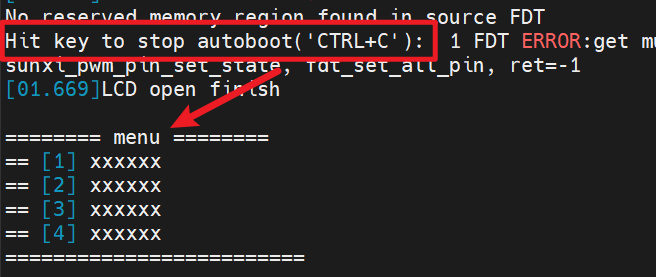
剩下的菜单程序编写就是根据实际功能来开发了。
